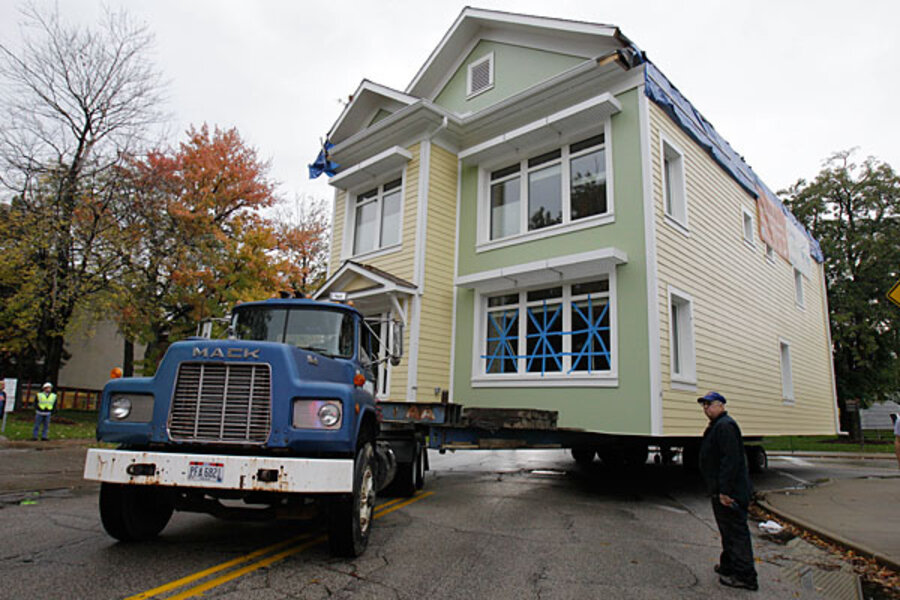Record-low percentage of Americans moved between 2010 and 2011
Loading...
| Los Angeles
There are many casualties of the Great Recession, including jobs, homeownership, retirement savings, and consumer confidence. Those issues are well known, but here’s one that isn’t as frequently discussed: Americans’ mobility.
In a nutshell, bad times mean staying put, demographers and economists say. Uncertainty means clinging to the familiar, which more often than not means maintaining the residence you already have.
The issue affects Americans’ aspirations about getting married and having a family. And it can be a big factor as they think about what constitutes a dream home, when to retire, and where to move in retirement.
“When people are being challenged about their homes and their jobs, their primary focus shifts from one of thriving to one of surviving,” says Ronald Hill, professor of marketing at the Villanova School of Business in Pennsylvania. “That is one solid trend that all the unfolding data seem to support.”
On Tuesday, the US Census Bureau released the latest data from its Current Population Survey, examining topics that include the likelihood of people moving and how the rate of moving is changing over time.
The survey shows that some well-known, long-term trends – such as older people relocating from the snowy Northeast to the toasty Southwest, and young people moving from rural areas to cities – are on hold, at least until the economy picks up. And no one is predicting that anytime soon.
Some of the key findings in the survey are:
• The percentage of people who changed residences between 2010 and 2011 – 11.6 percent – is the lowest recorded rate since the Current Population Survey began collecting such statistics in 1948. The rate was 20.2 percent in 1985, 11.9 percent in 2008 (a record low at the time), and 12.5 percent in 2009.
• When people moved a considerable distance between 2008 and 2009 – 500 or more miles – it was most likely for employment-related reasons. That kind of factor was cited by 43.9 percent of such movers, while 11.6 percent said they moved for housing-related reasons. On the other hand, when people didn't move far – less than 50 miles – 40 percent did so for housing-related reasons.
• As of 2010, the majority of Americans – 59 percent – lived in the state in which they were born. The state with the highest such percentage was Louisiana (78.8 percent), followed by Michigan (76.6 percent), Ohio (75.1 percent), and Pennsylvania (74.0 percent). Conversely, in four states – Alaska, Arizona, Florida, and Nevada – as well as in the District of Columbia, less than 40 percent of residents were born there.
The findings not only reflect the current economic climate, but they also serve as a potential blueprint for legislators, city planners, and others trying to plan for the future.
“This report is important for those who make decisions about where to invest public dollars, which are scarce,” says Cheryl Carleton, assistant professor of economics and statistics at the Villanova School of Business. “If more people are staying put in urban or suburban areas close to cities, then dollars could [or] need to be spent improving and maintaining the infrastructure there.”
What is most compelling to Kenneth Johnson, senior demographer at the Carsey Institute at the University of New Hampshire in Durham, is a dramatic slowing of migration to states such as Florida, Arizona, and California. He also notes a slowdown in people moving out of states such as New York and Massachusetts.
“These findings coincide with data from other recent studies that I’ve done,” Mr. Johnson adds.
Clara Rodriguez, a sociology professor at Fordham University in New York, is struck by what she says is not a rosy picture for young people, who typically move a lot and purchase housing. But now they’re not, because they’re graduating without finding jobs.
Also, she says, older people are deferring their retirement moves to sunny climes because they are forced to continue working.
“We should all care because the diminished mobility retards economic growth,” Professor Rodriguez says. “Where there are jobs, the best people can’t fill them because they can’t sell their homes in other states.”
While she laments what that means for the mixing of regional cultures, others see it differently.
“If there is less migration and people are more attached to their communities, they will have more incentive to invest in their communities, both with time and money,” says Professor Carleton.





